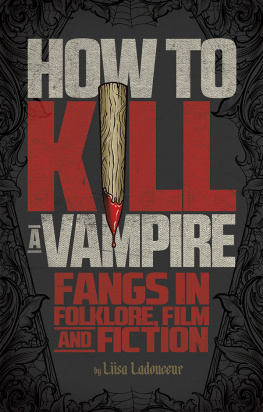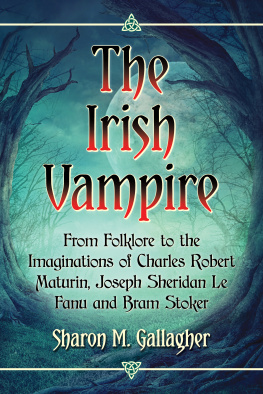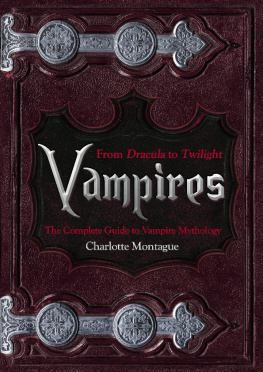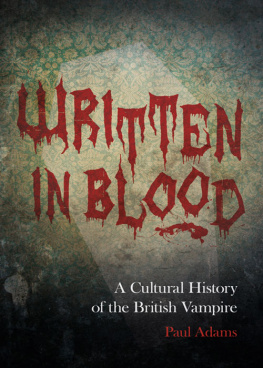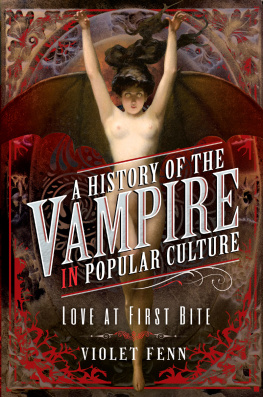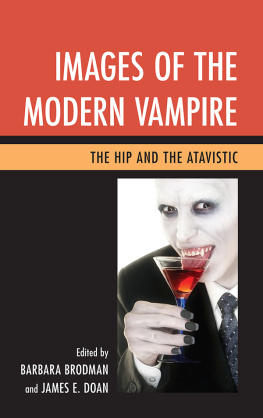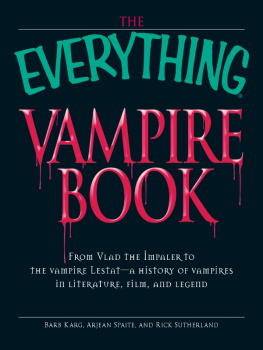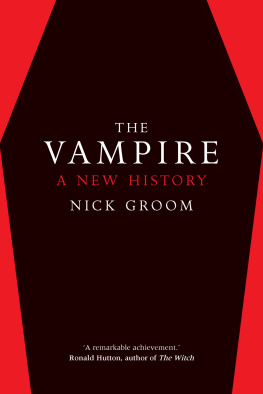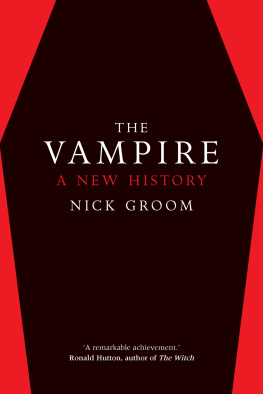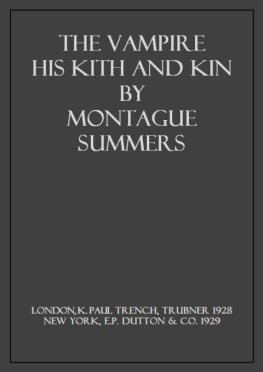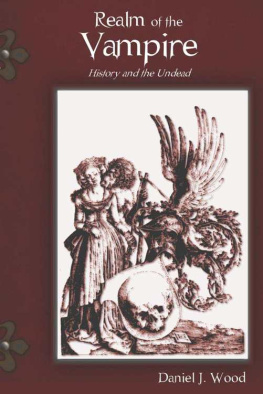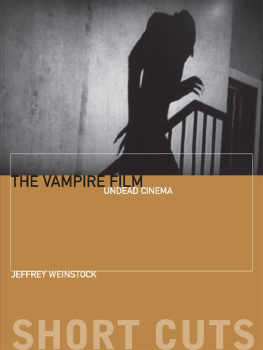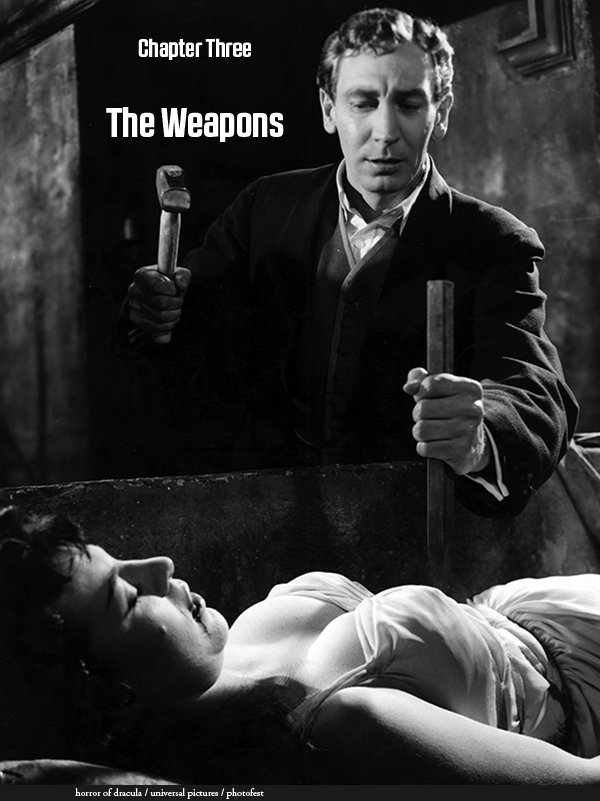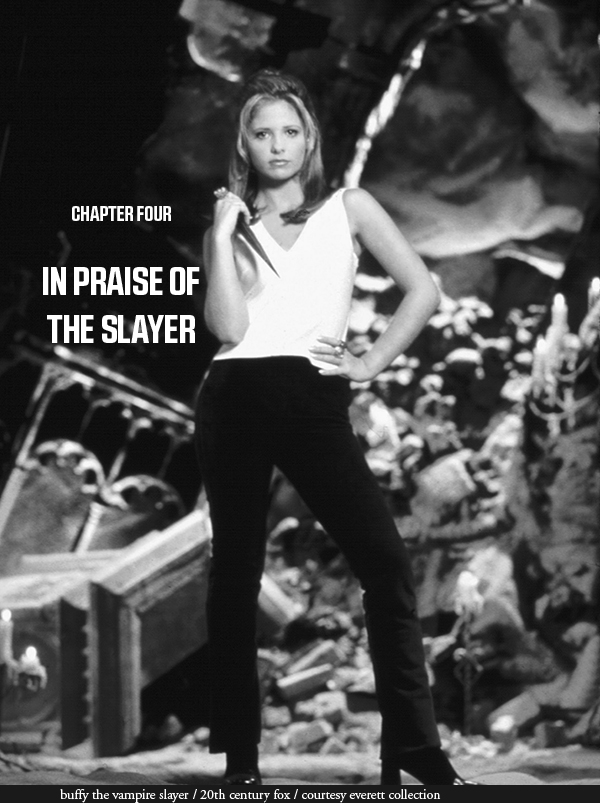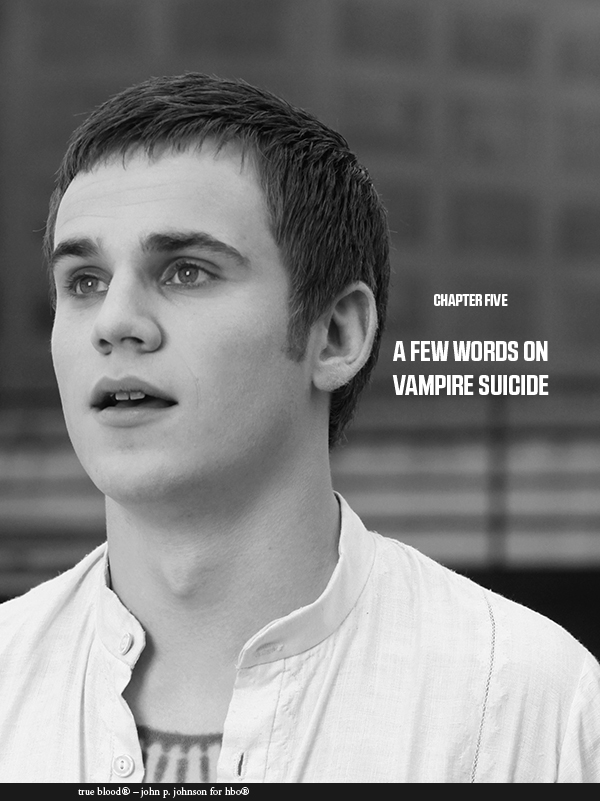This one is for Carolfangbanger and true friend.
And for all the Lost Boys, wherever you are.
To die, to be really dead... that must be glorious.
Bela Lugosi as Dracula
The bats have left the bell tower
The victims have been bled
Red velvet lines the black box
Bela Lugosis dead
Undead undead undead...
Bela Lugosis Dead by Bauhaus
Authors Note
This book is not an encyclopedia. It makes no promises to include every vampire story ever told. Ive tried my best to document the key moments in the evolution of the vampire legend, specifically as it relates to how to kill them, with an admitted bias towards my area of expertise, which is English-language horror of the 20th century. Should you find notable omissions or wish to suggest your own favourites, I am more than happy to hear from you. My contact information can be found at LiisaLadouceur.com.
A word of warning: spoilers lurk within. Ive made an attempt not to disclose twists of contemporary TV series unnecessarily, but please beware that youre going to stumble upon plenty of plot in this book. And that once youve begun, theres no turning back...
Introduction
The Sleep of Reason Produces Monsters; Or, the Vampire and Why It Needs to Be Destroyed
How do you kill something that is already dead? And why would you want to? Well, if that dead thing is about to tear the flesh from your neck and suck your blood til theres none left, you might think its a rather good idea. What? You dont believe these things exist? The undead. Vampires. Of course they do.
Walk into any bookstore, movie theatre, costume shop or toy store and you will find themthose hypnotic eyes staring out at you from countless photos and posters and product packages, looking gothic or grotesque or just plain gorgeous but always with a hint of danger, maybe a flash of fangs. And we regularly invite them into our homes: into our living rooms in horror films from Dracula to Blade or popular television series such as Buffy the Vampire Slayer and The Vampire Diaries ; between the bedsheets with us on the pages of scary stories by Stephen King and Anne Rice or the deluge of supernatural young adult novels spawned by Stephenie Meyers gazillion-selling Twilight Saga; sometimes we even let them sit down with our children at the breakfast table in the guise of Count Chocula cereal. We eat, play and sleep with them. We dream about them. We argue about them. We fall in love with them. They are entrenched in our imaginations, our fantasies and our fears. There may not be a vampire specimen in any natural history museum yet, but, yeah, vampires are totally real.
This isnt to suggest that vampires actually walk amongst us as corporeal beings, lurking in the shadows waiting to bite our necks and drain us of blood. And this book isnt a how to guide for those people who seriously believe that they do and want to wage a war against them. Nor does it pretend they are real for the sake of a joke; this is not the vampire version of The Zombie Survival Guide . Rather, its a serious look at a make-believe monster I feel strongly has much to teach us about real life and, especially, death.
The story of the vampire has been told many times. So many times, in fact, that what once was a simple charactera dead human who rises from the grave to feast upon the blood of the livingis now one of the most complex of all monsters, of all myth. Over time, the traditions of different cultures and imaginations of various writers have brought new (and sometimes contradictory) dimensions to the legend. Some vamps walk in the daylight, others are burned by the sun. Some can shapeshift into bats or wolves or mist. Some cant bear to murder humans for food and so they subsist on animal blood, others are brutal killers. Some are handsome, others, not so much. Some are aristocrats living in castles. Some go to high school. From 15th century Wallachian Gypsies to 17th century Greek Orthodox priests to 19th century Irish novelists to 21st century Hollywood screenwriters, everyone has had their reasons for adapting the vampire storytelling rules to suit their own purposes. But there is one thing all these vamps have in common: they are predators that canand shouldbe destroyed.
Since its the topic of the book you are holding, that bears repeating: every culture with a vampire legend has a prescribed means of getting rid of them. No society, when confronted with the threat of a vampire in their midst, says, Cool, come on in and let me fix you a drink. Would you like to meet my daughter? And even though vampires have become much more sympathetic and attractive in modern timesto the point that they are now considered suitable prom dates for teens and costume ideas for toddlers, for better or worsethey are still monsters. And monsters exist to be slain.
I dont say this because I hate vampires. I love vampires. I love vampire movies, vampire books, vampire board games, vampire toys. I have playlists of songs about vampires on my iPod. Ive reported about these things as a journalist and talked about them on TV . Ive written poetry about vampires. I own several pairs of fake fangs, which Ive used at Halloween to dress up as a vampire nun, vampire cheerleader, vampire cowgirl, vampire cat, etc. If there were a vampire sports team, Id be a season ticket holder. If one showed up at my door, I would invite it in.
It would probably be cool to say this fascination all started when I was given a copy of Bram Stokers seminal novel Dracula as soon as I could read. But Id be lying. Nor did I grow up watching Universal monster movies or all the Hammer horror flicks on late-night TV . No, my first vampire love (well, besides Count von Count, the muppet from Sesame Street ) was The Lost Boys , the 1987 film starring Kiefer Sutherland and the two Coreys, about a gang of teen bad-boy bloodsuckers. As was often the case with horror fans in the 1980s, I was initially drawn in by the poster and its tag line: Sleep all day. Party all night. Never grow old. Never die. Its fun to be a vampire. I dont know how many times I watched that movie, but I know I never got tired of it. I know that I wanted to be like Star, the films half-vamp hippie chick who ran with the vampires. I too wanted to ride on the back of motorcycles, live in an underground cave and lure the cute new guys in town into doing bad things after dark. But there were no vampire gangs in my town. So my search for creatures of the night generally happened in the library and the video rental store. And, heaven, was there a lot to sink my teeth into. Tony Scotts 1983 film The Hunger , starring David Bowie and featuring an opening sequence with the gothic rock band Bauhaus singing its chilling song Bela Lugosis Dead, seduced me. That track actually led me to Lugosis black and white horror movies (mostly crap public domain VHS tapes I bought for spare change), especially his iconic role in the mighty classic Dracula ! Between that and paperbacks of Anne Rices Interview with the Vampire (1976) and The Vampire Lestat (1985) I was well on my way to obsession. By the time I read Poppy Z. Brites 1992 debut novel Lost Souls , the first book I found explicitly connecting vampires and the goth subculture I also loved, I knew I had found my monster.

